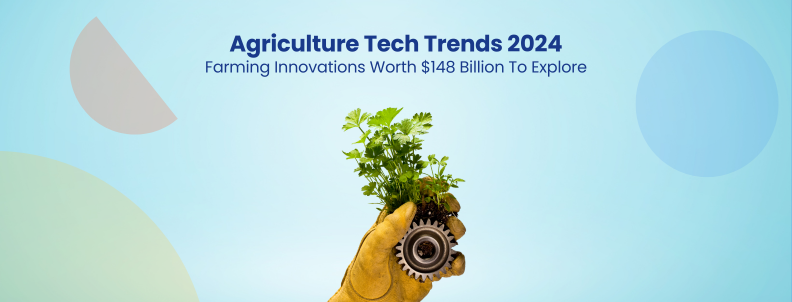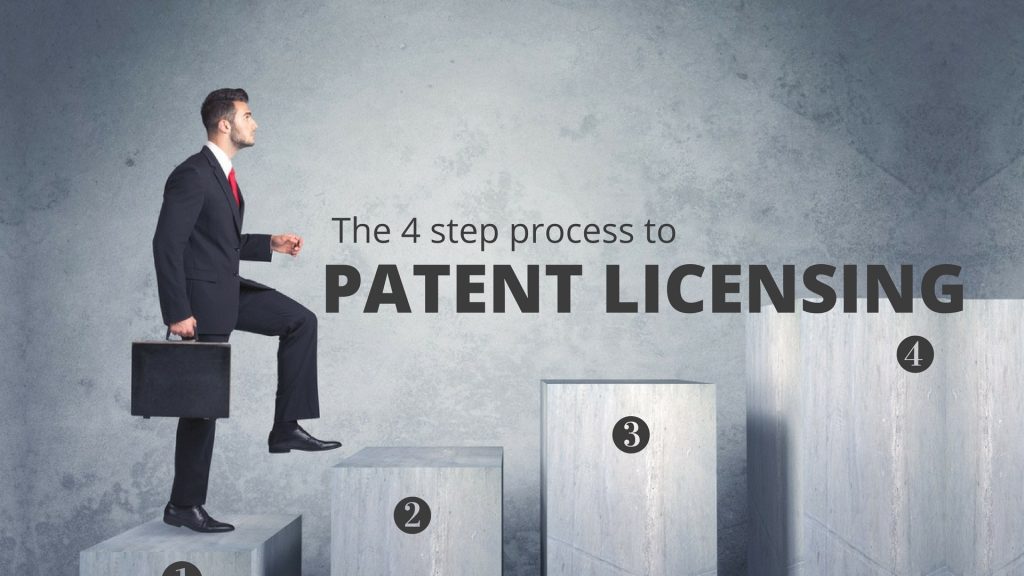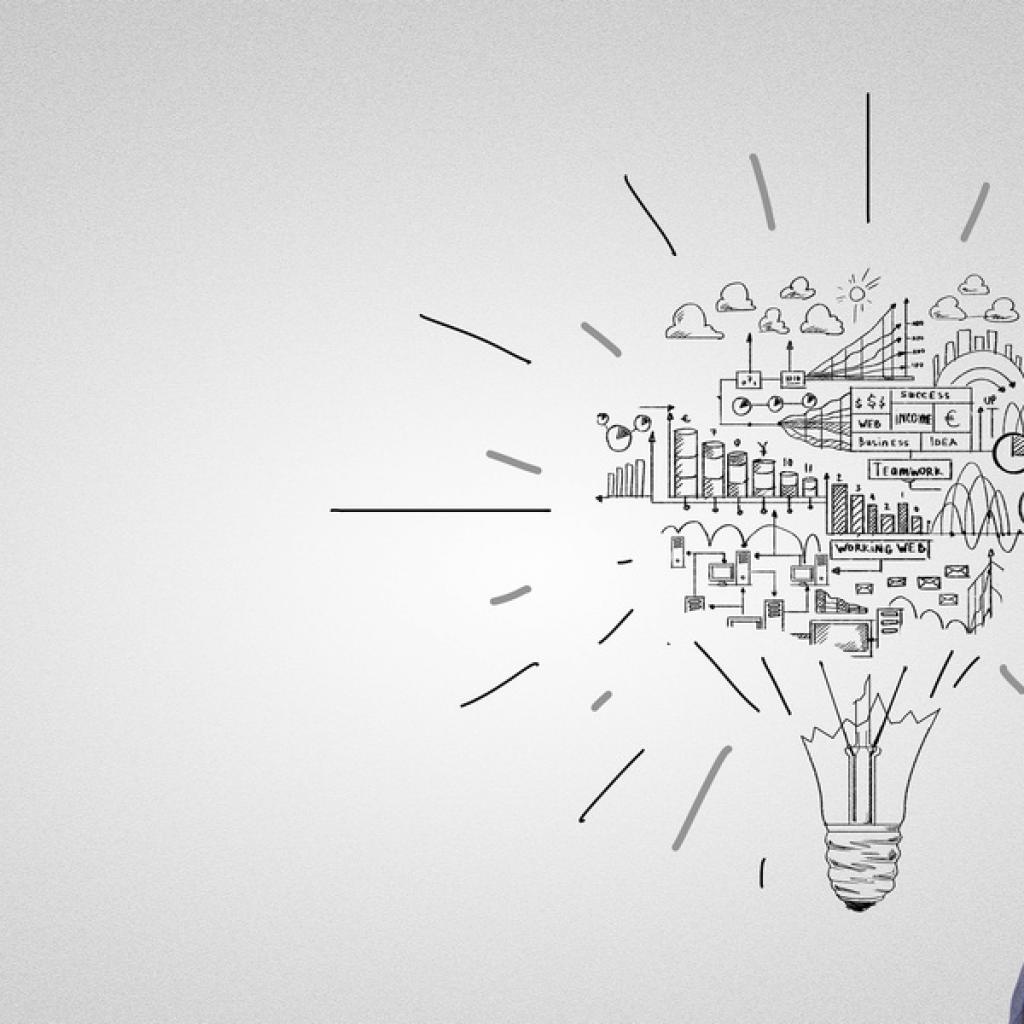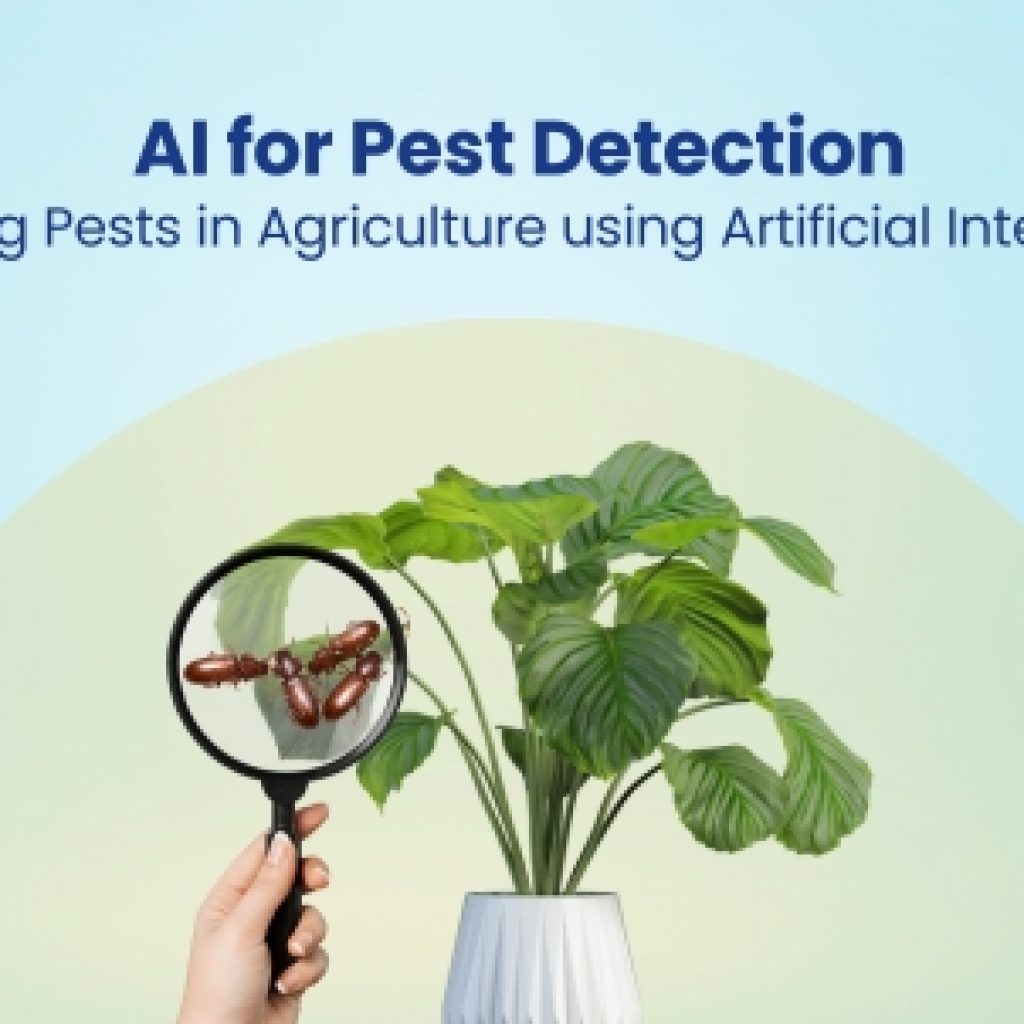The global agricultural technology market will grow to approximately $56.74 billion by 2030. The world’s largest agricultural companies, like Cargill Inc. and Bayer, are rapidly developing agrotech solutions for farmers using cloud computing, special sensors, drones, and AI.
This rising interest in agricultural technologies is due to increasing urbanization, the need to monitor livestock health, and government provisions for agrotech solutions.
This report details many such technology trends and identifies the key innovators in the agricultural landscape in 2024 and beyond.
We’re compiling a comprehensive report on these trends. Fill out the form below, and you’ll be among the first to get a PDF of those insights directly in your inbox.
1. Advanced Drones and UAVs in Agrotech
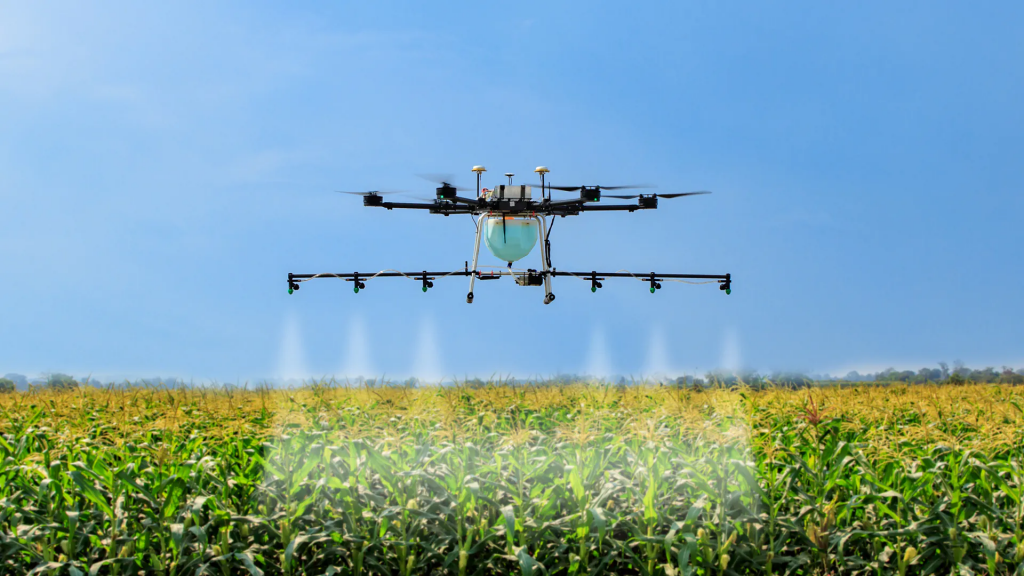
As of 2022, drones occupied about 11% of the total agriculture market, valued at $4.1 billion. This drone market share will grow to approximately $18.22 billion by 2030. Several companies and government organizations use unmanned aerial vehicles (UAVs) to curb the labor shortage and efficiently use chemical products.
Why are Drones becoming a trend?
Owing to the increasing adoption of precision agriculture with local government and community support, various innovations in drone applications are significantly growing in regions such as North America, Europe, Asia-Pacific, and Latin America.
Top Innovators Developing Drones for Agriculture
Initiatives from LSU AgCenter & World Governments
- The U.S. Department of Agriculture National Institute of Food and Agriculture (USDA) has partnered with LSU AgCenter to provide training on various aspects of drone technology, such as how to use them, write codes for the autonomous functioning of the drone as well as various sensors and software employed in them. LSU AgCenter has also received a grant of $800,000 for this program.
- China has outpaced every other country in implementing UAVs in agriculture. Their native drone companies, like XAG, now have over 42,000 drones covering over 1.2 million daily flights.
- India may soon witness an agriculture drone revolution as the Indian government has provided subsidies to train farmers and increase the adoption of UAVs and drones to improve agricultural productivity. IFFCO plans to buy 2500 drones distributed among 5000 ruralpreneurs to boost precision agriculture in India.
Green Plus’s Multipurpose Drone for Precision Agriculture
Green Plus has developed a patented precision agriculture drone. It resembles a transport drone equipped with imaging sensors but has an AI system to control the setup. The device captures real-time field images to gather data on crop status, pest presence, fertilizer needs, and seed distribution. The device can perform multiple functions simultaneously or independently as per the requirement.
Acquisitions and collaborations among agricultural drone companies
- Agribotix LLC is helping farmers use low-cost agricultural drones, data, and analytics to boost crop production and reduce costs. The company has partnered with MMC, an industrial drone manufacturer, to provide more advanced agriculture drone solutions equipped with cameras and analytics for higher-end farming needs.
- Big entities, like John Deere, have formed strategic alliances with drone development companies to enhance precision agriculture technologies. Through their collaborator program, Deere has collaborated with Precision AI to develop artificial intelligence-powered agricultural drones for plant-level herbicide applications.
- Terra Drone has acquired Avirtech to expand its reach in precision agriculture. Avirtech specializes in pesticide spraying and mapping services using drones and artificial intelligence (AI) and has reduced operating costs by 30% in Indonesia and Malaysia.
The growing interest of large companies and continuous developments in drone technology on data collection and precision agriculture indicate that drone technology will continue to be a trending topic in the agriculture sector.
2. Using Predictive AI for intelligent forecasting
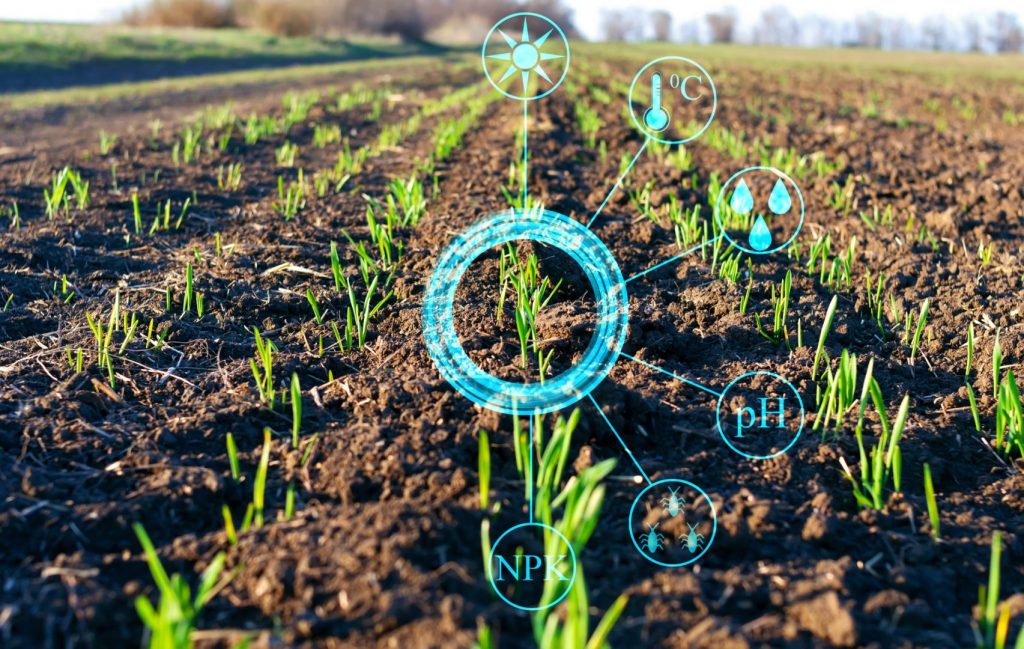
Artificial intelligence (AI) in agrotech will reach a $4.65 billion market size by 2030, comprising predictive analytics, machine learning, and computer vision applications. Tech industry leaders, like Microsoft, actively contribute to this trend through initiatives like Project FarmVibes to optimize farming via drone-based data capture.
Why is Predictive AI becoming a Trend in Agrotech?
Predictive AI can be immensely helpful to farmers, enabling them to understand crop health, effectively use fertilizer, identify pests & crop diseases, and recommend solutions that solve the issue without unintended consequences to the soil and yield. These systems are trained to analyze and compare diverse datasets to identify patterns and predict future outcomes.
Predictive models will soon significantly improve agricultural produce’s efficiency, cost-effectiveness, and sustainability. Prominent players such as John Deere, Bayer, NTT DOCOMO INC, and CNH are keen on developing predictive assistance to carry out agricultural tasks.
The ultimate aim is to maximize production and optimize agricultural practices.
Top Companies & Institutions Inducting Predictive AI into Agriculture
John Deere
- John Deere has recently filed more than 20 patents based on developing predictive maps to improve the efficiency of agricultural tasks such as predicting yield quality or machine drive tracks on a field.
- One of Deere’s patented technologies, the cotton harvesting system, can be controlled based on a generated predictive map to adjust travel speed and avoid plugging. The system optimizes the harvesting process by considering the impact of the harvesting process on the soil. Combined with its predictive mapping feature, this system can ultimately manage and deliver higher-quality cotton harvest.
- It comprises in-situ sensors coupled with machine learning algorithms to detect the yield capability of a specific geographic location by collecting data such as prior irrigation, soil moisture, soil type, etc.
Bayer
- One of Bayer’s subsidiaries, The Climate Corporation, is helping connect smallholder farmers in rural India with crop protection through predictive AI. Their mobile app named Farmrise™ delivers daily agronomic, location-specific insights to Indian farmers to support crop protection practices.
- Bayer has also recently filed a patent to safeguard an invention related to developing a device capable of predicting the residual amount of plant-protecting agents in the parts meant for human and animal consumption.
Penn State’s College of Agricultural Sciences
Recently, the US Department of Agriculture has provided a grant of $500,000 to a team of researchers at Penn State’s College of Agricultural Sciences to develop national-level predictive models to understand how changes in soil texture and structure influence water availability for crops. These findings indicate that prediction models will soon be integral to the agricultural sector.
Acquisitions and Collaborations among Predictive AI Companies in Agrotech
Taranis, an Israeli precision agriculture intelligence platform, harnesses advanced computer vision, data science, and deep learning algorithms for effective field monitoring.
In 2021, Taranis and Albo Climate announced a partnership to simplify the verification of carbon sequestration in farmland. By utilizing satellite-based remote sensing to reduce verification costs for Soil Organic Carbon (SOC), this collaboration aims to help agriculture retailers expand carbon programs and assist farmers in quickly entering the carbon credit markets.
In 2022, Taranis announced its extended partnership with Drone Nerds and DJI. This collaboration combined the latest drone tech, operational efficiencies, and AI to offer precise insights for ag retailers, co-ops, and farmers.
Recommended Report: 10 Most Significant Food Tech Innovation Trends
3. Farm robots for precision farming and harvesting
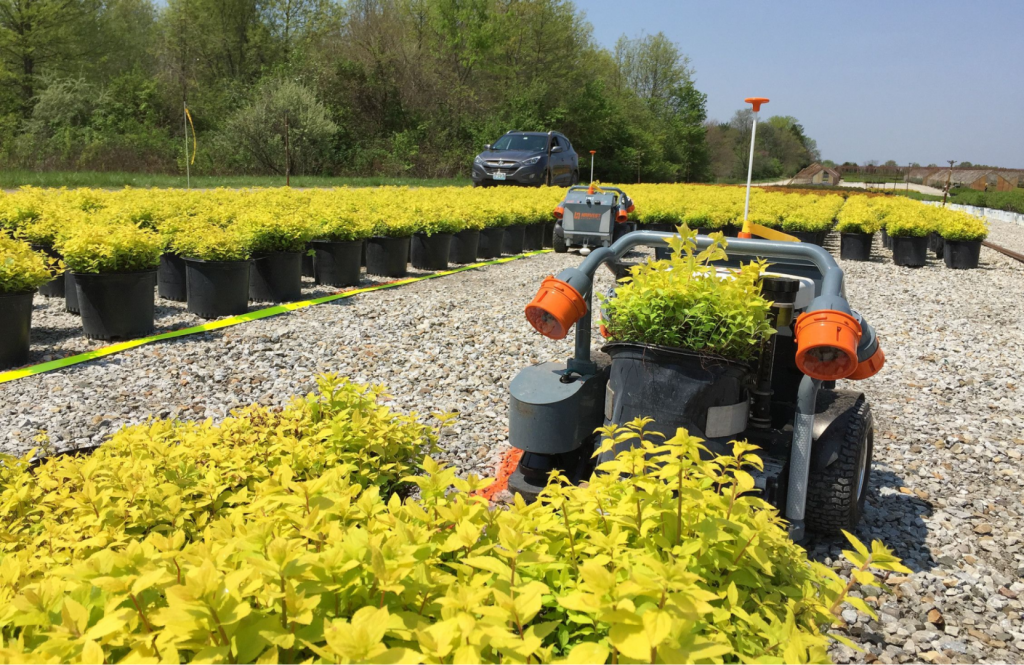
Credit: Harvest Automation
According to McKinsey, fewer than 5% of farmers across Asia, North America, Europe, and South America were using agricultural robots in 2022. The market size for this field was valued at around $7 billion. However, the same market will rise to approximately $24 billion by 2030, with North America claiming a significant market share.
By utilizing advanced technologies such as GPS, sensors, and artificial intelligence, these robots can precisely execute agricultural processes like planting, irrigation, and pesticide application. Companies like Harvest Automation Inc. have made material-handling robots that work alongside humans in nurseries, greenhouses, etc.
Why are robots becoming a trend in agriculture?
Robotic technologies have been extensively used in weed management, crop harvesting, soil analysis, and livestock monitoring. Companies like the Australian-born RIPPA have created fully autonomous robots that can cover five acres daily on solar power to eliminate weeds using mechanical tools or herbicides.
EcoRobotix, a Swiss robotic weed-management company, has received tremendous recognition and financial aid from the Swiss government for its ultra-high precision agricultural technology. Their technology distinctly identifies crops and weeds in real-time and delivers appropriate crop care, either fertilizer or herbicide, without manual labor or extensive human intervention.
Innovations in Farm Robots from Governments and Companies
UKRI
- The Department for Environment, Food & Rural Affairs U.K. and UKRI have committed $13.2 million in 2022 to support agricultural and horticultural automation and robotics.
- This initiative seeks to enhance productivity, decrease labor requirements, and promote sustainable farming practices. Prominent companies such as Deere combined the efficiency of predictive mapping and automatic controls to automate various agricultural processes.
Carbon Robotics
- Carbon Robotics has launched LaserWeeder, an innovative device that employs artificial intelligence to enable the robot to instantly identify and eliminate weeds using thermal energy while in movement. The company has also filed two patents, one for laser weed eradication and the other for object detection.
- Carbon Robotics’ patented lighting system enables the LaserWeeder to operate day or night in all weather conditions with millimeter accuracy. They applied for multiple patents from 2016 to 2020, signifying continuous growth and strong backing.
Other Patents held by Carbon Robotics
| Patent Number | Title |
| US20180126553A1 | System and calibration, registration, and training methods |
| USD892885S1 | Robotic arm segment |
| US20170066139A1 | Reconfigurable robotic system and methods |
AGCO
- AGCO, a prominent player in the agriculture and machinery industry, has invested in Apex.AI and JCA Industries for automated farming. This strategic alliance enabled AGCO to utilize Apex.OS to create a software stack for Xaver, expanding its real-time autonomous capabilities.
- A fleet of cloud-connected Fendt Xaver robots is managed via an app, offering up-to-the-minute data from each unit, including location, status, and diagnostics.
- Acquisition of JCA Industries to enhance its engineering and software development capacities, expediting the progress of highly automated and autonomous machinery.
“JCA is one of the most advanced developers of autonomous machine technologies for off-road OEMs, and this acquisition will accelerate AGCO’s delivery of machine automation and autonomous systems that improve farmer productivity.”
Eric Hansotia, Chairman, President, and CEO of AGCO
Fill out the form below for an in-depth research report on the companies commercializing farm robots.
Terada Seisakusho
National Agriculture and Food Research Organization and Terada Seisakusho have also collaborated to develop an automated weeding machine for the tea garden.
Monash University

Credit: Monash
- Monash University has developed a robotic fruit-picking apparatus and method for efficient and accurate fruit harvesting. The vision system identifies ripe fruit, plans a picking sequence, and helps avoid collisions. The robotic arm extends the suction element, which securely grasps the fruit, and then switches to a passive mode, allowing the fruit to move freely.
- After picking, the system can retract the suction element and release the fruit into a storage container. This innovative technology streamlines fruit harvesting by automating the process and ensuring the delicate handling of the produce.
- A fruit-harvesting robot named MARS (Monash Apple Retrieving System), developed by Associate Professor Chao Chen and a Department of Mechanical and Aerospace Engineering team, has won Victorian Project of the Year at the 2023 Engineers Australia Excellence Awards.
Acquisitions in Farm Robot Companies
- John Deere acquired Bear Flag Robotics for $250 million. Bear Flag’s technology enables a machine to work in a field autonomously.
- Additionally, John Deere acquired SparkAI, a New York-based startup that helps robotic systems resolve edge cases in real time. SparkAI will provide contextual cues to enable John Deere’s autonomous tractor to make more accurate maneuvers.
4. IoT Solutions for Farm Monitoring
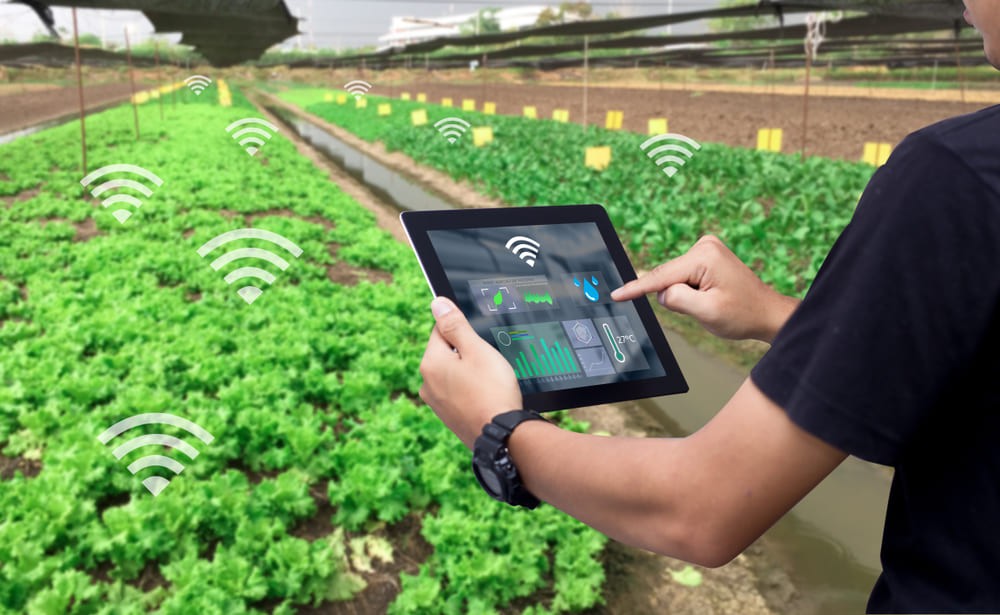
The global agriculture IoT market is projected to reach $84.5 billion by 2031. IoT connects sensors and devices to farming equipment, enabling real-time monitoring and control of soil moisture, weather conditions, and crop health.
A study revealed that IoT-enabled agriculture saw a 70–80% reduction in water usage. This example shows that a data-driven approach helps farmers make informed decisions, optimize resource usage, and increase crop yields, improving agricultural productivity and sustainability.
Why are IoT and field monitoring systems becoming a trend in agrotech?
IoT and field monitoring systems are becoming increasingly popular in agrotech because they improve crop yields, reduce water usage, enhance pest and disease control, optimize labor, and enable better decision-making. As IoT technology becomes more affordable, its adoption in agriculture is expected to expand in the coming years.
Companies and organizations leading the trend
- The Hungarian government is at the forefront of IoT solutions and field monitoring initiatives in developing economies. They launched Hungary’s First Field Monitoring Laboratory, leveraging Libelium’s IoT technology. This groundbreaking laboratory has been established to assist farmers in making informed decisions for their field monitoring.
- CNH Industrial has completed the acquisition of Augmenta following a two-year collaboration to expedite the advancement of their pioneering Sense & Act technology. Their focus lies in automating agricultural tasks through IoT and artificial intelligence, wherein data is instantly processed directly within the system.
- Dhiway and CultYvate have partnered to combine Dhiway’s state-of-the-art CORD blockchain technology with CultYvate’s IoT data. By harnessing the advanced features of CORD, the integrated solution will elevate the dependability and traceability of agricultural data, ultimately leading to increased efficiency and productivity.
- Bayer has partnered with Microsoft to develop cloud-based data tools and data science solutions for the food and agriculture industry.
- Lumen Technologies has received a $1.2 billion contract from the USDA for network services. The aim is to provide an all-inclusive wide area data transport service, ensuring secure remote access, contact center, and cloud connectivity solutions to all USDA sites.
- These advancements will empower USDA to proficiently oversee essential farming, food and nutrition, forestry, and rural economic development services.
Innovations in IoT applications for agriculture
- CenturyLink has developed an IoT-based irrigation system for managing water distribution in a specific area using a network of microwells, sensors, and a computing system.
- The method uses sensors to measure weather, light, and water in the soil to figure out how much water the plants need and plan to water them. This water distribution plan is mapped to small wells at specific regions with instructions for precise irrigation.
- These wells have pumps and integrated irrigation systems that can communicate wirelessly with the computing system using IoT. They can also be designed to use solar power and have lights or screens to show information. This helps save water and grow crops more efficiently.
Partnerships and Acquisitions in IoT Companies for Agriculture
- In July 2021, John Deere and Ericson, Brazil, partnered to provide mobile IoT solutions in the agricultural sector. The agreement includes equipping John Deere’s factories with 5G equipment to contribute to implementing an IoT-based digital transformation strategy. By November 2020, John Deere had obtained 5G licenses in five counties in Iowa and Illinois. This was part of the FCC auction for the Citizens Broadband Radio Service (CBRS) 3.5 GHz spectrum.
- In August 2021, John Deere acquired Bear Flag Robotics for $250 million for its autonomous driving technology. Deere started working with Bear Flag in 2019. Since then, Bear Flag has successfully deployed its autonomous solution on a limited number of farms in the US.
- Ace Global Business Acquisition Limited, a special purpose acquisition company, entered a merger agreement with LE Worldwide Limited for $150 million upon seeing its growth potential in greenhouse farming solutions. LE’s main products are consumer and commercial LED lighting solutions that integrate with various IoT and smart city projects. It is a key component provider of data-enabled greenhouse farming solutions.
5. Regenerative agriculture is the next big thing.
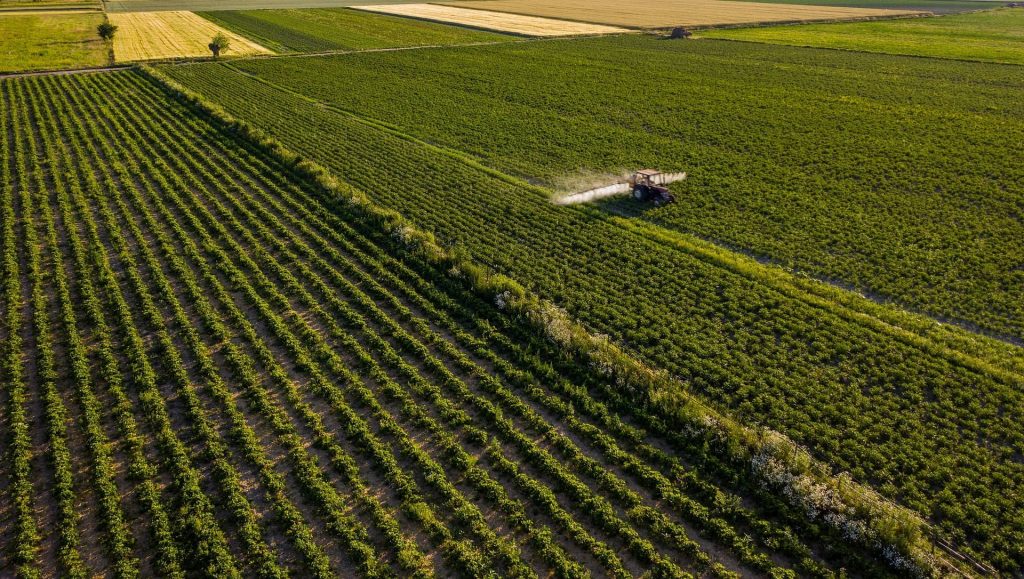
The regenerative agriculture (RA) market size will reach an estimated $16.8 billion by 2027. It’s a farming method that uses natural processes to enhance soil health, improve nutrient cycling, restore landscape function, and produce food and fiber while preserving or increasing farm profitability. Practitioners use tactics that integrate biological and ecological processes to increase production and restore landscape functionality.
Why do we need Regenerative Agriculture?
Regenerative agriculture presents a holistic solution to climate change, benefiting farmers, the environment, and consumers. Customized adoption of practices such as conservation tillage and cover crops can significantly increase farmers’ income and resilience to extreme weather.
By restoring degraded farmland and improving soil health, regenerative methods prevent deforestation and grassland conversion, contributing to environmental conservation. These practices also enhance biodiversity through habitat creation for various species. Optimizing inputs and reducing chemical usage promote sustainable farming.
Governments Endorse Regenerative Agriculture
- Government entities have been interested in regenerative farming practices and have various initiatives to promote its adoption. For instance, in British Columbia, regenerative agriculture is officially endorsed as a climate mitigation strategy backed by initiatives like the Agritech Concierge Program.
- The United States USDA offers programs like SARE and CSP, while Europe has launched initiatives such as CAP and Green Deal to encourage regenerative agriculture initiatives. Australia similarly supports it through initiatives like the Sustainable Agriculture National Research Program.
Companies and organizations leading the trend
- Big players such as PepsiCo’s Positive Agriculture strategy aim to apply regenerative farming practices across its seven million-acre footprint, emphasizing sustainability and improving livelihoods.
- Yara, a Norwegian chemical company, focuses on decarbonizing operations to produce fossil fuel-free ammonia and championing regenerative agriculture as vital for a sustainable food future.
- Alongside using predictive AI, Bayer has embraced innovative approaches in regenerative agriculture, such as incorporating strategies like carbon farming, cover crops, hybrid wheat, biological substitutes for traditional chemical fertilizers and supplements, and integrating digital farming tools.
Breakthrough innovations in regenerative agriculture
- KULA Bio has come up with new ideas for regenerative agriculture. They’ve created a patented special growth substance for microorganisms that helps with nitrogen fixation. This medium incorporates a compound nutrient source, soluble salts, buffers, carbon sources, and metal sources, strategically balanced to optimize the growth of nitrogen-fixing microorganisms while ensuring their viability.
- Furthermore, KULA bio’s invention introduces a unique approach by utilizing a compound nutrient source with lower solubility than its constituent salt components, preventing microorganism toxicity. This curated formulation includes key components like ammonium, magnesium, and phosphate, with specific concentrations tailored to support microbial growth.
- In addition, introducing a carbon source, metal carbonate, and trace metals enhances the medium’s efficacy. This invention holds immense promise for sustainable agriculture and environmental health, serving as a foundation for biofertilizers that can significantly enhance crop yields and soil fertility.
Partnerships in the Regenerative Agriculture Space
- Bosch and BASF formed a joint venture named Bosch BASF Smart Farming (BBSF) GmbH to sell smart farming technologies worldwide. Their Smart Spraying solution offers real-time weed identification and management day and night.
- Unilever, AXA, and Tikehau Capital combined their industry expertise and formed a regenerative agriculture transition venture. They invested €120 million in BioBest, a Brazilian pest and disease control company building crop enhancement solutions.
“With the backing of Tikehau Capital’s private equity regenerative agriculture strategy, in conjunction with the strategic partnership with AXA and Unilever, Biobest is poised to expedite its expansion efforts, making a substantial contribution to agriculture while fortifying our preeminent position in sustainable crop management.”
– Jean-Marc Vandoorne, CEO of Biobest
Future Outlook of Agricultural Technologies
Agrotech is on the fast track to mainstream use across the globe. Several new government initiatives are coming up to support this field. One example is Agriculture Breakthrough, a commitment agreed upon by 45 world leaders at COP26. This agreement is to accelerate the transition to sustainable and resilient agriculture systems, focusing on reducing emissions, enhancing adaptation, and improving livelihoods.
The trends discussed above on using artificial intelligence, drones, specialized farming robots, and IoT integrations hope to enable cultivators to meet the fast-rising food requirements of the world’s population for the foreseeable future.
Keeping up with these advancements and the respective innovators active in the space will better position you to identify vital opportunities for growth and collaboration.
Don’t forget to fill out the form below to receive a PDF of the final report in your inbox once it’s complete.
Authored By – Suborna, Vishakha and Samriddh, Intelligence Team
Edited By – Hemanth Shenoy, Marketing

